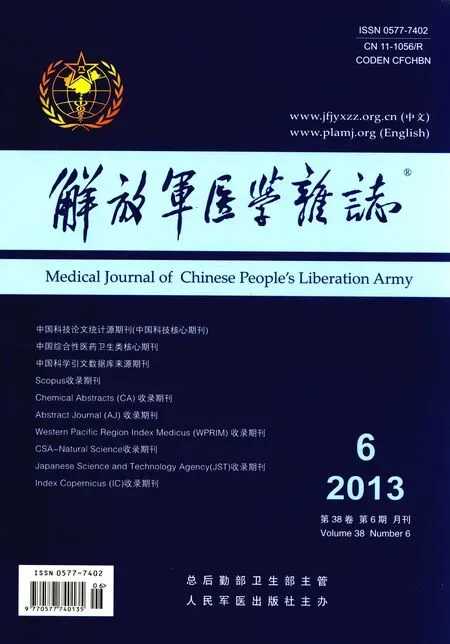海军某部官兵功能性胃肠病各部位重叠的流行病学研究
王子恺,崔立红,彭丽华,郭旭,孙刚,王巍峰,杨云生
海军某部官兵功能性胃肠病各部位重叠的流行病学研究
王子恺,崔立红,彭丽华,郭旭,孙刚,王巍峰,杨云生
目的研究海军某部官兵各部位功能性胃肠病(FGIDs)的重叠情况,为该人群相关疾病的诊治提供依据。方法2006年11月-2007年4月,采用罗马Ⅲ调查问卷对3个不同服役地域的8600名海军官兵进行多级分层随机整群抽样问卷调查,记录被调查者的一般情况。采用EpiData3.02软件进行数据录入,利用SPSS 13.0软件对各部位FGIDs的重叠情况进行分析。结果共回收有效问卷7574份。两部位及以上FGIDs重叠率为46.7%。功能性胃十二指肠病(FGD)+功能性肠病(FBD)重叠占两部位FGIDs重叠的比例最高,为51.2%(339/662);其次为功能性食管病(FED)+FBD,为15.4%(102/662)。三部位FGIDs重叠中,FED+FGD+FBD的比例最高,为44.4%(151/340);其次为FGD+FBD+功能性腹痛综合征(FAPS)重叠,占20.3%(69/340)。四部位FGIDs重叠中,最常见的是FED+FGD+FBD+FAPS重叠,占57.7%(94/163)。五部位FGIDs重叠只有FED+FGD+FBD+FAPS+功能性肛门直肠病(FAD)一种形式。南区服役的海军官兵FGIDs患病率为49.8%(987/1983),较北区[31.8%(1064/3351)]和东区[23.8%(533/2240)]高。南区单部位FGIDs患病率为44.9%,较东区(59.0%)和北区(58.4%)低,但南区2~5个部位的FGIDs重叠率均高于东区和北区。结论 海军官兵中各部位FGIDs重叠常见,其中FGD+FBD重叠率最高。不同服役地域各部位FGIDs重叠存在差异。应当重视海军官兵各部位FGIDs重叠的预防和诊治。
军事人员;胃肠疾病;流行病学研究
罗马Ⅲ标准将成人功能性胃肠病(functional gastrointestinal disorders,FGIDs)按部位划分为六大类[1-6],即功能性食管病(functional esophageal disorders,FED)、功能性胃十二指肠病(functional gastroduodenal disorders,FGD)、功能性肠病(functional bowel disorders,FBD)、功能性腹痛综合征(functional abdominal pain syndrome,FAPS)、胆囊和Oddi括约肌功能障碍(gallbladder and sphincter of Oddi disorders,GSOD)和功能性肛门直肠病(functional anorectal disorders,FAD),各部位疾病常合并存在[7-9]。目前按六大部位分类的FGIDs重叠研究较少,本研究针对海军官兵这一特殊人群,对FGIDs各部位重叠情况进行调查分析。
1 资料与方法
1.1研究对象 纳入2006年11月-2007年4月在东区、南区和北区三处地域服役的解放军海军现役官兵。
1.2调查方法 采用多级分层随机整群抽样方法进行随机抽样,抽样人数为8600人。采用FGIDs罗马委员会2006年发布的罗马Ⅲ调查问卷,结合调查对象一般情况设计而成。诊断标准严格按照FGIDs的罗马Ⅲ标准[1-6],以被调查者填写的问卷答案为基础进行分类和诊断。
1.3数据录入和质量控制 由专业人员进行统一授课及答疑后,发放调查表,现场统一填写。问卷回收后由专人逐份检查并剔除不合格问卷。问卷由两人统一编号,一人编写、一人复核,确保编号正确唯一。采用EpiData 3.02软件进行数据录入,录入前对所有变量的合理取值进行控制,采用双人双录双校对形式并进行一致性检验和纠错。
1.4统计学处理 采用SPSS 13.0软件进行统计分析,采用χ2检验及多重反应分析法进行统计学分析,P<0.05为差异有统计学意义。
2 结 果
2.1一般情况 共回收问卷8106份,应答率94.3%(8106/8600);其中合格问卷7574份,合格率93.4%(7574/8106)。海军官兵FGIDs的总体患病率为34.1%(2584/7574),其中FED患病率为10.1%(764/7574),FGD为16.7%(1268/7574),FBD为24.5%(1854/7574),FAPS为4.4%(336/7574),GSOD为0.05%(4/7574),FAD为3.4%(259/7574)。单个部位的FGIDs患者为1378例,占FGIDs总患病数的53.3%(1378/2584)。本调查中2个及2个以上部位重叠率为46.7%,具体重叠形式分为4种,包括2个部位重叠662例,占25.6%(662/2584),3个部位重叠340例,占13.2%(340/2584),4个部位重叠163例,占6.3%(163/2584),5个部位重叠41例,占1.6%(41/2584)。
2.2FGIDs各部位重叠情况 FGD+FBD重叠占两部位FGIDs重叠的比例最高,为51.2%(339/662,P<0.05);其次为FED+FBD和FED+FGD,所占比例分别为15.4%(102/662)和12.1%(80/662),两者间比较差异无统计学意义(P>0.05)。在三部位FGIDs重叠者中,FED+FGD+FBD组合所占比例最高,为44.4%(151/340,P<0.05),其次为FGD+FBD+FAPS和FGD+FBD+FAD组合,所占比例分别为20.3% (69/340)和16.8%(57/340,P>0.05)。在四部位FGIDs重叠中,最常见的是FED+FGD+FBD+FAPS组合,占57.7%(94/163,P<0.05)。五部位FGIDs疾病重叠41例,且只有FED+FGD+FBD+FAPS+FAD一种组合形式(表1)。
2.3不同服役地域海军官兵各部位FGIDs重叠情况 东区、南区和北区三处服役地域的海军官兵FGIDs患病率分别为23.8%(533/2240),49.8%(987/1983)和31.8%(1064/3351);南区FGIDs患病率最高,其次为北区和东区,三地区间差异均有统计学意义(P<0.05)。单部位FGIDs患病率南区最低,为44.9%(P<0.05),东区和北区患病率无差异(P>0.05);但是南区服役的海军官兵中,2~5个部位的FGIDs重叠率均高于东区和北区(表2)。

表1 海军官兵FGIDs各部位重叠总体情况Tab.1 General circumstance of the overlaps of FGIDs in Chinese navy

表2 不同服役地域海军官兵FGIDs各部位重叠情况Tab.2 The overlaps of FGIDs in different regions of military service
3 讨 论
FGIDs临床十分常见,近年来的资料表明,许多FGIDs患者有重叠现象[7-9],即同时有两种或两种以上的FGIDs存在。疾病重叠现象使FGIDs的病情变得复杂,增加了诊治的难度和医疗资源的消耗。重叠现象的出现提示FGIDs可能存在一些共同的病理生理机制,如胃肠动力障碍、内脏高敏感性,以及脑-肠轴功能紊乱等[10]。目前从消化道六大部位分类角度进行的FGIDs重叠研究较少,特别是针对海军官兵这一特殊群体进行的FGIDs重叠研究尚未见报道。
一项采用罗马Ⅰ标准进行的、针对澳大利亚普通人群的流行病学调查显示,FGIDs患病率为34.6%,其中55.7%的患者存在两种或两种以上的疾病重叠,FGIDs总体重叠率为19.2%[11]。姚欣等[12]采用罗马Ⅲ标准对492例门诊患者进行了FGIDs重叠情况调查,发现两种及以上的FGIDs重叠率为38.6%。本研究发现海军官兵中存在两个及以上部位FGIDs重叠者占所有FGIDs患者的46.7%。张振华等[13]针对解放军某部现役官兵的流行病学调查发现,FGIDs重叠率为47.7%,与本研究结果相似。
海军官兵具有显著的人群特征,如长期在舰艇上工作和生活,训练强度较高,生活作训空间狭小,噪音强,湿热,饮用淡水及新鲜蔬菜水果有限等,上述因素可能导致海军官兵的FGIDs重叠率较普通人群高。本研究发现,两部位的FGIDs重叠最为常见,其中又以FGD+FBD比例最高,其次为FED+FBD,这与目前FGIDs单病种重叠研究的侧重点和结论一致。另外,本研究发现,东区、南区和北区三处不同服役地域海军官兵FGIDs的总体患病率不同,多部位重叠率也存在差异,该结果基本符合三地区的实际情况,考虑与三个地区当时所担负的军事任务、工作重点及训练强度等有一定关系。当然,军龄、工作性质、饮食习惯等其他诸多因素均可对各部位FGIDs的重叠产生影响,本研究未对各部位具体疾病的重叠情况进行分析,有待进一步探讨。
总之,本研究初步明确了中国海军现役官兵六大部位FGIDs的重叠情况,该结果提示我们应充分重视海军官兵FGIDs各部位重叠的预防和诊治。
[1]Galmiche JP, Clouse RE, Bálint A, et al. Functional esophageal disorders[J]. Gastroenterology, 2006, 130(5): 1459-1465.
[2]Tack J, Talley NJ, Camilleri M, et al. Functional gastroduodenal disorders[J]. Gastroenterology, 2006, 130(5): 1466-1479.
[3]Longstreth GF, Thompson WG, Chey WD, et al. Functional bowel disorders[J]. Gastroenterology, 2006, 130(5): 1480-1491.
[4]Clouse RE, Mayer EA, Aziz Q, et al. Functional abdominal pain syndrome[J]. Gastroenterology, 2006, 130(5): 1492-1497.
[5]Behar J, Corazziari E, Guelrud M, et al. Functional gallbladder and sphincter of oddi disorders[J]. Gastroenterology, 2006, 130(5): 1498-1509.
[6]Bharucha AE, Wald A, Enck P, et al. Functional anorectal disorders[J]. Gastroenterology, 2006, 130(5): 1510-1518.
[7]Kaji M, Fujiwara Y, Shiba M, et al. Prevalence of overlaps between GERD, FD and IBS and impact on health-related quality of life[J]. J Gastroenterol Hepatol, 2010, 25(6): 1151-1156.
[8]De Vries DR, Van Herwaarden MA, Baron A, et al. Concomitant functional dyspepsia and irritable bowel syndrome decrease health-related quality of life in gastroesophageal reflux disease[J]. Scand J Gastroenterol, 2007, 42(8): 951-956.
[9]Jung HK, Halder S, McNally M, et al. Overlap of gastrooesophageal reflux disease and irritable bowel syndrome: prevalence and risk factors in the general population[J]. Aliment Pharmacol Ther, 2007, 26(3): 453-461.
[10]Corsetti M, Caenepeel P, Fischler B, et al. Impact of coexisting irritable bowel syndrome on symptoms and pathophysiological mechanisms in functional dyspepsia[J]. Am J Gastroenterol, 2004, 99(6): 1152-1159.
[11]Koloski NA, Talley NJ, Boyce PM. Epidemiology and health care seeking in the functional GI disorders: a population-based study[J]. Am J Gastroenterol, 2002, 97(9): 2290-2299.
[12]Yao X, Yang YS, Shang J, et al. Investigation on the symptoms overlap of functional gastrointestinal disorders diagnosed according to the Rome Ⅲ criteria[J]. Med J Chin PLA, 2007, 32(12): 1249-1251. [姚欣, 杨云生, 尚军, 等. 以罗马Ⅲ标准诊断的功能性胃肠疾病的症状重叠状况研究[J]. 解放军医学杂志, 2007, 32(12): 1249-1251.]
[13]Zhang ZH, Lu LH, Shen GH. Epidemic characteristic analysis on funcdonal gastrointestinal disorders in Army[J]. Guide Chin Med, 2009, 7(21): 7-8. [张振华, 路丽华, 申广浩. 部队功能性胃肠疾病流行特征分析[J]. 中国医药指南, 2009, 7(21): 7-8.]
Epidemiological study of overlapping of involved organs in functional gastrointestinal disorders in the Chinese naval servicemen
WANG Zi-kai1, CUI Li-hong2, PENG Li-hua1, GUO Xu1, SUN Gang1, WANG Wei-feng1, YANG Yun-sheng1*
1Department of Gastroenterology and Hepatology, General Hospital of PLA, Beijing 100853, China
2Department of Gastroenterology and Hepatology, Navy General Hospital, Beijing 100048, China
*Correspondence author, E-mail: sunny301ddc@126.com
This work was supported by the “Eleventh Five-Year Plan” for Medical Science Development of PLA (06G113)
ObjectiveTo study the overlapping of involved organs in functional gastrointestinal disorders (FGIDs) occurring in the Chinese naval servicemen, and to provide a sound basis for its diagnosis and treatment.MethodsFrom November 2006 to April 2007, a questionnaire survey was conducted in 8600 officers and soldiers of Chinese naval force in three regions using randomized, stratified, multistage sampling method. All respondents completed the Rome Ⅲ Modular Questionnaire. The collected data were double input by EpiData3.02 sothware and analyzed by SPSS 13.0 sothware.Results7454 valid questionnaires were retrieved. The incidence of overlapping was 46.7% involving two to five sites. In two-site overlap of FGIDs, the incidence of overlap functional gastroduodenal disorder (FGD) and functional bowel disorder (FBD) was shown to be highest (51.2%, 339/662), followed by the overlap of functional esophageal disorder (FED) and FBD (15.4%, 102/662). In three-site overlap of FGIDs, the overlapping rate of FED, FGD and FBD was the highest (44.4%, 151/340), followed by that of FGD, FBD and functional abdominal pain syndrome (FAPS) (20.3%, 69/340). The commonest four-site overlap of FGIDs included FED, FGD, FBD and FAPS (57.7%, 94/163). The five-site overlap of FGIDs was the combination of FED, FGD, FBD, FAPS and functional anorectal disorder (FAD). The incidence of FGIDs in southern military region was 49.8% (987/1983), which was higher than that of northern (31.8%, 1064/3351) and eastern (23.8%, 533/2240) regions. The incidence of FGIDs of single organ was 44.9% in southern military region, which was lower than 59.0% in eastern and 58.4% in northern region. The incidence of the illness involving two to five sites were higher in southern military region as compared with that of eastern and northern regions.ConclusionsThe rate of overlapping of FGIDs at different sites is common in the Chinese naval servicemen. Thereis a difference in rate of overlapping between different military areas. More athention should be paid to the prevention and treatment of overlapping organs in FGIDs in the Chinese naval servicemen.
military personnel; gastrointestinal diseases; epidemiologic studies
R574.4
A
0577-7402(2013)06-0450-03
2012-12-27;
2013-04-06)
(责任编辑:熊晓然)
军队“十一五”科技攻关重点项目(06G113)
王子恺,主治医师,博士研究生。主要从事功能性胃肠病和消化道微生态的临床与基础研究
100853 北京 解放军总医院消化科(王子恺、彭丽华、郭旭、孙刚、王巍峰、杨云生);100048 北京 海军总医院消化科(崔立红)
杨云生,E-mail:sunny301ddc@126.com

